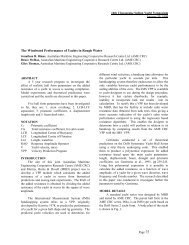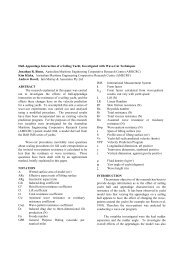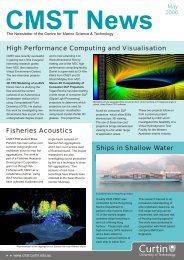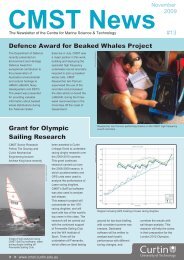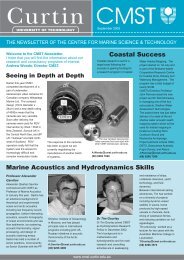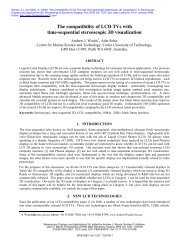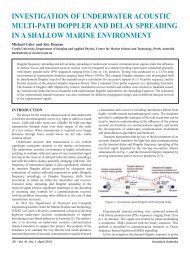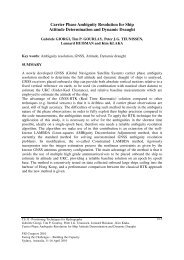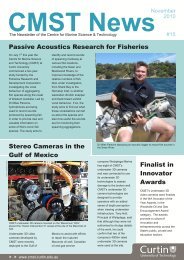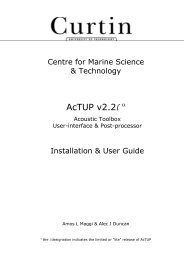Blue whale calling in the Rottnest trench-2000, Western ... - ANP
Blue whale calling in the Rottnest trench-2000, Western ... - ANP
Blue whale calling in the Rottnest trench-2000, Western ... - ANP
Create successful ePaper yourself
Turn your PDF publications into a flip-book with our unique Google optimized e-Paper software.
can be used to localise <strong>call<strong>in</strong>g</strong> animals. Except where multipath signals can be discrim<strong>in</strong>ated,<br />
localis<strong>in</strong>g <strong>call<strong>in</strong>g</strong> animals is not possible us<strong>in</strong>g a s<strong>in</strong>gle hydrophone.<br />
2) Methods<br />
The study site was located <strong>in</strong> <strong>the</strong> region of <strong>the</strong> <strong>Rottnest</strong> <strong>trench</strong>, an <strong>in</strong>dentation <strong>in</strong> <strong>the</strong> <strong>Western</strong><br />
Australian cont<strong>in</strong>ental shelf which beg<strong>in</strong>s approximately 22 km WNW of <strong>the</strong> western end of<br />
<strong>Rottnest</strong> Island. The shelf slope <strong>in</strong> <strong>the</strong> <strong>trench</strong> region drops steeply to 1000 m depth. The general<br />
location of <strong>the</strong> study site is shown on Figure 2, while <strong>the</strong> deep and <strong>in</strong>dented nature of <strong>the</strong> <strong>trench</strong><br />
can be seen on Figure 3. Along <strong>the</strong> <strong>Western</strong> Australian cont<strong>in</strong>ental shelf between <strong>the</strong> 100-500 m<br />
depth contours, flows <strong>the</strong> Leeuw<strong>in</strong> current, a sou<strong>the</strong>rly current of warm tropical water<br />
approximately 50-200 m deep. Over <strong>the</strong> study period of early January to April <strong>2000</strong>, <strong>the</strong><br />
Leeuw<strong>in</strong> current was particularly strong, with current speeds estimated at up to1.5 knot (0.75 ms -<br />
1 ) based on observations of moor<strong>in</strong>gs and drift rates. The sharp <strong>in</strong>dentation of <strong>the</strong> <strong>trench</strong> ly<strong>in</strong>g<br />
across <strong>the</strong> path of <strong>the</strong> Leeuw<strong>in</strong> current may be expected to give rise to complex oceanographic<br />
conditions <strong>in</strong> <strong>the</strong> area.<br />
Thirteen sets of record<strong>in</strong>gs were made. The details for each set are listed <strong>in</strong> Table 1. Eleven sets<br />
were made with a drift<strong>in</strong>g package (shown by <strong>the</strong> circles on Figure 2) and two with moored<br />
equipment (shown by <strong>the</strong> square and triangle on Figure 2). The drift<strong>in</strong>g package used a Massa<br />
TR1025C hydrophone suspended from a hous<strong>in</strong>g conta<strong>in</strong><strong>in</strong>g a purpose built pre-amplifier (40 dB<br />
ga<strong>in</strong>) and Sony TCD D-8 digital tape deck operated at 32 kHz sample rate to give 4 hour<br />
record<strong>in</strong>gs per tape. System response was l<strong>in</strong>ear from 20 Hz to 14.5 kHz. To reduce surge from<br />
<strong>the</strong> surface gear and flow noise from cable strum, <strong>the</strong> hydrophone cable was spirally wrapped<br />
with tw<strong>in</strong>e and suspended on rubber strops from <strong>the</strong> hous<strong>in</strong>g while <strong>the</strong> hous<strong>in</strong>g was suspended<br />
from a rope weighted and buoyed to create a catenary. A depth meter attached to <strong>the</strong> hous<strong>in</strong>g<br />
was used to log <strong>the</strong> hous<strong>in</strong>g, and hence hydrophone, depth. Under most conditions <strong>the</strong><br />
hydrophone was at 55 m depth. Drift<strong>in</strong>g sets were made dur<strong>in</strong>g daytime, concurrent with <strong>the</strong> boat<br />
based observations.<br />
A moored system was set at <strong>the</strong> head of <strong>the</strong> <strong>trench</strong> (eastern <strong>trench</strong> end, square symbol, Figure 2,<br />
set 2459 Table 1) <strong>in</strong> 160 m water. This comprised <strong>the</strong> same hydrophone and electronics as <strong>the</strong><br />
drift<strong>in</strong>g system, but with <strong>the</strong> tape deck operated by timer on a 3 m<strong>in</strong>ute sample time every 44<br />
m<strong>in</strong>utes. The gear was suspended from <strong>the</strong> moor<strong>in</strong>g surface floats. Sixty samples were collected<br />
over a two day period (10-12th January).<br />
A second moored system compris<strong>in</strong>g a deepwater hous<strong>in</strong>g (<strong>the</strong> 'bluey' logger, set 2466 Table 1)<br />
was set on <strong>the</strong> bottom <strong>in</strong> 450 m of water on <strong>the</strong> nor<strong>the</strong>rn <strong>trench</strong> edge (large triangle symbol,<br />
Figure 2) through 8th March to 10th April. This system comprised a General Instruments C-32<br />
hydrophone connected to custom built electronics compris<strong>in</strong>g an A-D converter and<br />
microprocessor controlled sampl<strong>in</strong>g and storage system (10 kHz sample rate, 90 s samples every<br />
10 m<strong>in</strong>utes, 9.1 GByte SCSII storage disk). The frequency response of this system was calibrated<br />
from < 1 Hz to 3.5 kHz. This system retrieved 4827 samples over 33.5 days.<br />
Cont<strong>in</strong>uous sections of sea noise from <strong>the</strong> DAT tape decks was digitised at 651 Hz us<strong>in</strong>g a<br />
calibrated DataPhysics DP430 spectral analyser card <strong>in</strong>stalled <strong>in</strong> a 166 MHz PC. The digital data<br />
from <strong>the</strong> 'bluey' logger was transferred to an IDE disk on a PC. All data analysis was <strong>the</strong>n carried<br />
out <strong>in</strong> <strong>the</strong> Matlab environment.<br />
6



